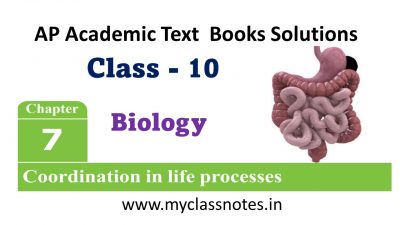AP Class 10 Coordination in life processes Notes | AP Class X Biology Notes – Coordination in life processes notes -AP Class X Coordination in life processes Notes – Here is Text book complete answers and solutions. coordination in life processes 10th class biology notes, coordination in life processes notes, coordination in life processes, coordination in life process, coordination in life processes 10th class biology, coordination in life processes 10 class notes, coordination in life processes 10 class, coordination in life processes information, coordination in life processes class 10 ppt
coordination in life processes class 10 ssc.
AP Class 10 Coordination in life processes Notes

AP Class 10 Coordination in life processes Notes – AP Class X Coordination in life processes – Key Points.
• The food taken by us has to be broken down into constituent substances for proper digestion, assimilation and energy releasing processes.
• The human digestive system involves both the muscular and nervous systems.
• A special nervous system that exists in the gut consist of nearly 100 million nerves that coordinates the muscular activity ,blood flow,digestion and absorption of nutrients and other activities of the food canal (gastro intestinal tract).
• The hormone Ghrelin secreted in the stomach is responsible for hunger generating sensations. Another hormone leptin that gets secreted suppresses hunger.
• Taste can be identified easily only when the tongue is pressed against the palate.
coordination in life processes 10th class biology notes, coordination in life processes notes, coordination in life processes, coordination in life process, coordination in life processes 10th class biology, coordination in life processes 10 class notes, coordination in life processes 10 class, coordination in life processes information, coordination in life processes class 10 ppt
coordination in life processes class 10 ssc.
• Taste and smell are closely related. The chemoreceptors present in the nose and the tongue trigger signals in the form of nerve impulses to the brain where the smell and taste is detected.
• The saliva secreted maintains an alkaline medium that aids in digestion of starch. Our mouth secretes acid as well ,this gives protection to our mouth from harmful bacteria etc., Under the action of autonomous nervous system Saliva released by the salivary glands moistens the food to make chewing and swallowing easier.
• The muscular and sensory organ in the oral cavity is the tongue which is not only gustatory in function but also performs different functions including, shifting and mixing the food in the oral cavity and swallowing.
• The mechanism for swallowing is coordinated by the swallowing centre in the brain stem.
• Contraction and relaxation of the muscles in the gut brings in a wave like motion that propels the food forward and is called peristalsis. This is a muscular wave that travels the entire length of the food canal. This is involuntary and under the control of autonomous nervous system as well as gut nervous system.
• The muscular contractions of the stomach churns the food into a semiliquid substance known as chyme. Entry of chyme into the duodenum is regulated by a muscle called as the pyloric sphincter.
• The strong acid (HCl) renders the pH in stomach acidic causing the protein digesting enzymes to swing into function.
• Juices secreted in the stomach breaks down the food into a smooth mixture called chyme.
• The mucus lining of the stomach protects it from damage by its own acids.
• The coordination among the processes of digestion, respiration and circulation is necessary for utilization and oxidation of food and transport of the nutrients. Muscular and nervous control helps to carry out the processes in a regulated manner.
For Better Check this 👇.
